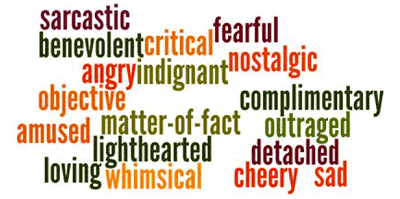Lesson Template
Part 1 - TEKS Glossary and Syllabus
- Lesson title: Identifying Rhetorical Devices in Arguments to Aid Understanding
- Student-friendly summary of lesson: You will be able to identify strategies authors use in order to make their arguments more easily understood.
- At least 3-5 key words in the lesson, including their definitions from the TEKS Glossary:
Key Word |
TEKS Glossary Definition |
|---|---|
| Appeal | In rhetoric, the means of persuasion in an argument. According to Aristotle, there are three fundamental appeals to convince a person: reason (logos), ethics (ethos), and emotion (pathos). |
| Detail | The facts—facts, observations, incidents, statistics, evidence of research, references to experts, causes and effects that support the attitude or tone in a composition.
|
| Diction | Choice of words in speaking or writing for clear and effective expression.
|
| Imagery | The use of language to create mental images and sensory impressions (sight, smell, taste, touch, hearing, and sometimes motion). Imagery can be used for emotional effect and to intensify the impact on the reader.
|
| Parallelism | A rhetorical device in which the same grammatical structure is used within a sentence or paragraph to show that two or more ideas have equal importance. |
| Repetition | In a text, repeated use of sounds, words, phrases, or clauses to emphasize meaning or achieve effect.
|
| Rhetoric | The art or study of using language effectively and persuasively.
|
| Rhetorical device | A technique that an author or speaker uses to influence or persuade an audience. |
| Rhetorical fragment | A sentence fragment used deliberately for a persuasive purpose or to create a desired effect.
|
| Rhetorical fragment | A sentence fragment used deliberately for a persuasive purpose or to create a desired effect.
|
| Rhetorical question | A question that requires no answer. It is used more to produce an effect and is generally stronger than a direct statement.
|
| Syntax | The arrangement and sequence of words in sentences, clauses, and phrases.
|
| Thesis | 1) A statement or premise supported by arguments. 2) The subject or theme of a speech or composition.
|
| Tone | The author’s particular attitude, either stated or implied in the writing.
|
Part 3 - Sections of the Lesson
Add any documents/downloads within each section and/or any suggestions regarding interactive enhancement components.
Lesson Section |
Title of Section |
Downloadable Document |
Activity/Enhancement |
|---|---|---|---|
| 1 | Introduction | Wordle | |
| 2 | Analyzing Rhetorical Devices in an Argument , Part I | Cartoon of king instructing his son on what is most important for his future. The video of dog and man barking at talking heads barking on TV. Link to Pitts’ website—photo of Pitts? Photos/clip art of Bush, Obama, and Hitler. |
Graphic included. Response to video. |
| 3 | Analyzing Rhetorical Devices in an Argument, Part II | ||
| 4 | Determining Tone | Wordle graphic of tone words—www.wordle.net | |
| Resources | Supporting Resources |
Introduction
Although there are three main phases of creating an argument and using rhetoric—the discovery of ideas, the arrangement of ideas, and the expression of ideas—this lesson focuses on the expression of ideas or on the stylistic choices writers make. Because the range of choices is so broad, the activities in the lesson will have you zero in on getting “DDIST”—or getting “dissed,” but in a positive way, a way that will help you remember the basics of rhetorical analysis:
- D = Diction — The choice of words in speaking or writing for clear and effective expression.
- D = Detail — The facts—facts, observations, incidents that support the attitude or tone in a composition.
- I = Imagery — The use of language to create mental images and sensory impressions (sight, smell, taste, touch, hearing, and sometimes motion). Imagery can be used for emotional effect and to intensify the impact on the reader. “Figurative language” can be categorized under imagery as well.
- S = Syntax — The arrangement and sequence of words in sentences, clauses, and phrases.
- T = Tone — The author’s particular attitude, either stated or implied in the writing.
Using DDIST, you will recognize and analyze some of the ways writers use language to manipulate you to their point of view. As Aristotle said, rhetoric is any “available means of persuasion.”
The cartoon below emphasizes that a ruler or leader must master the art of rhetoric to be effective, more so than learning any other subject. While this idea may seem extreme, everyone, not just future kings and presidents, can benefit from learning how to communicate in order to persuade other people and from learning how we are susceptible to the way others use language.

Overall, effectively expressed arguments will connect to the audience through appropriate and clear diction, with vivid images,with interesting sentences (syntax), and a tone suited to that particular audience. Effective arguments show us ways to be more civil with one another, unlike so much of our current public discourse, which is illustrated in this video cartoon by Jim Morin of The Miami Herald.
View the video cartoon.
In this lesson you will work with only one text, an editorial column by Leonard Pitts Jr. The biography on Pitts’ website says that he began writing for The Miami Herald as a critic in 1991, and that he has authored a syndicated column since 1994. Learn more about Pitts by visiting his website at http://leonardpittsjr.com/Biography.html.
In his column “We Need a History Lesson About Nazis,” published in August 2009, Pitts clearly connects with his audience as he expresses his concern about the ubiquitous use of the word “Nazi” in today’s society.
First, read the column below to learn what it’s about and whether you think it is an effective argument or not. And then read the commentary immediately following the column.

We Need a History Lesson About Nazis
By Leonard Pitts Jr.
I hope this column makes you sick.
See we’ll be talking about Nazis, something many of us are doing lately. Indeed, just this week a fellow named Joseph e-mailed me about a caller he heard on a radio show. The man, vexed over healthcare reform, likened President Obama to Adolf Hitler. Asked why, he said, “Hitler took over the car companies, then healthcare and then he killed the Jews.”
Said Joseph: “I almost swerved my vehicle off the road when I heard that.”
But the caller is hardly unique. Google “Obama + Nazis” and you get almost seven million hits. Nor is the phenomenon new. Substitute President Bush’s name and you get nearly 2.8 million.
Even granting that many of those hits are benign, it seems obvious the Nazis have invaded American political rhetoric in a big way. As in Rush Limbaugh declaring healthcare reform “a Hitler-like policy,” swastikas popping up at protest rallies, a poster depicting Obama with Hitler’s moustache and a pamphlet that says: “Act Now To Stop Obama’s Nazi Health Plan!”
It’s important to remember that the Nazis are passing out of living memory; U.S. soldiers of that era are said to be dying at the rate of 1,200 a day. Which makes it too easy, I think, for a nation of notorious historical illiteracy to remake the Nazis as some kind of all-purpose boogeymen for slandering political enemies and scoring cheap rhetorical points.
So I thought it would be good to make you sick, i.e., to spend a few minutes reminding some and teaching others what you invoke when you invoke the Nazi regime.
For the record, then: It was Nazis who shoved sand down a boy’s throat until he died, who tossed candies to Jewish children as they sank to their deaths in a sand pit, who threw babies from a hospital window and competed to see how many of those “little Jews” could be caught on a bayonet, who injected a cement-like fluid into women’s uteruses to see what would happen, who stomped a pregnant woman to death, who once snatched a woman’s baby from her arms and, in the words of an eyewitness, “tore him as one would tear a rag.”
That’s who the Nazis were, ladies and gentlemen—those obscenities plus six million more. They were the triumph of ideology over reason and even over humanity, the demonization of racial, religious and political difference, the objectification of the vulnerable other. And the authors of a mass murder that staggers imagination, still.
You would think, then, that where they are invoked to draw a parallel or make a point, it would be done with a respect for the incalculable evil the Nazis represent. You would think people would tread carefully, not because of the potential insult to a given politician (they are big boys and girls) but because to do otherwise profanes the profound and renders trivial that which ought to be held sacred by anyone who regards himself as a truly human being.
But in modern America, unfortunately, rhetoric often starts over the top and goes up from there. So fine, George W. Bush is “a smirking chimp.” Fine, Barack Obama is “a Chicago thug.” We have a Constitution, after all, and it says we can say whatever we want. It doesn’t say it has to be intelligent.
And yes, you are even protected if you liken Obama or Bush to Hitler. Yet every time I hear that, it makes me cringe for what it says about our collective propensity for historical amnesia and our retarded capacity for reverence. Once upon a lifetime ago, six million people with DNA, names and faces just like you and I, were butchered with gleeful sadism and mechanistic dispatch. Six million people.
You and I may no longer respect one another, but is it asking too much that we still respect them?
Commentary
Before analyzing Pitts’ expression of ideas, you need to understand the standard elements of his argument:
- Speaker: Leonard Pitts Jr.; he strives to appear ethical by giving examples from both sides of the political spectrum, through the use of quotations, and through the use of statistics, all showing that he has done his research; also, he uses the 1st person singular point of view, thus including himself along with everyone else
- Issue(s): Use of the word “Nazi” in casual debate or criticism
- Audience: Thinking, caring people like he is
- Thesis (Claim): Stop using the word “Nazi” except when talking about Hitler’s National Socialist Party and the genocide they wrought during the 1930s and 1940s
- Appeals: Predominantly emotional, but he uses logical appeals through the same devices he uses to prove he’s an ethical person
- Purpose: To get people to stop using the word “Nazi” in order to show respect for the victims of Nazi atrocities

Diction, Detail, and Imagery as Rhetorical Devices
Though Pitts’ column is filled with numerous examples of powerful diction, detail, and imagery choices, we don’t have the time or space to cover all of them. Instead, we will analyze examples from a few sections to see how these three devices work.
Below are the definitions again:
- D = Diction — The choice of words in speaking or writing for clear and effective expression.
- D = Detail — The facts—facts, observations, incidents that support the attitude or tone in a composition.
- I = Imagery — The use of language to create mental images and sensory impressions (sight, smell, taste, touch, hearing, and sometimes motion). Imagery can be used for emotional effect and to intensify the impact on the reader. “Figurative language” can be categorized under imagery as well.
Diction
In this part of the lesson, you will work with examples of Pitts’ diction that clearly relate to the overall meaning of the article. They are highlighted in the box below.
Diction Examples |
|
Read each sentence above carefully to understand the context of each highlighted word. Then match the correct diction choice to the connotation and effect by dragging A,B, C, D or E into the right column.
Detail
Details and images obviously consist of diction—and images often contain details. But in this section you will work only with some details that do not overlap with images. The highlighted words below represent different types of details writers use.
Diction Examples |
|
Think about the impact of the details in the five items above.
- seven million hits
- 2.8 million
- a pamphlet that says: “Act Now To Stop Obama’s Nazi Health Plan!”
- rate of 1,200 a day
- six million more . . . six million people . . . Six million people.
Keeping these details in mind, read the multiple choice question that follows. When you have an answer in mind, roll over it to see if you’re correct.
Question: Pitts uses these details for all of the following reasons EXCEPT—).
- To dramatize how many victims of Nazis there were
- To appeal to the sense of sight
- To prove that he has done his research
- To appeal to his readers’ logic
- To emphasize that he is of moral integrity
Imagery
Because diction, details, and images overlap, in this section you will work only with the images—groups of words that appeal to the senses. The examples highlighted below include appeals to different senses.
Imagery Examples |
|
Now, match the image with the sense it appeals to. Some could appeal to more than one sense, but choose only the most obvious for this exercise.
Now, match the five images below with the effect each has by dragging A, B, C, D, or E into the right column.
Syntax as a Rhetorical Device
Another powerful rhetorical technique that Pitts uses in his essay is the way he arranges the words in his sentences. He also includes incomplete sentences or fragments to make his points. Answer the following multiple choice questions about the syntax of the column, how Pitts controls and manipulates his sentences.
Four of Pitts’ paragraphs contain rhetorical fragments. Choose the “sentence” that’s really a fragment in each of these paragraphs.
Writers vary their sentence lengths to prevent monotony and to control emphasis. Below are the shortest sentences in the column, in the order of appearance:
- I hope this column makes you sick.
- But the caller is hardly unique.
- Google “Obama + Nazis” and you get almost seven million hits.
- Nor is the phenomenon new.
- Substitute President Bush’s name and you get nearly 2.8 million.
- So fine, George W. Bush is ’a smirking chimp.’
- Fine, Barack Obama is ‘a Chicago thug.’
- It doesn’t say it has to be intelligent.
- Six million people.
What is the function of the shortest sentences? to view the answer.
These words carry main points or key ideas.
CloseHere are the longest sentences in order of appearance:
Determining Tone
Tone is created by all the other rhetorical devices an author uses. Now that you have worked closely with several of the devices, you should have some understanding of the overall tone that underlies Pitts’ column. Before you decide on words that accurately describe his tone, you need to reread the column.

We Need a History Lesson About Nazis
By Leonard Pitts Jr.
I hope this column makes you sick.
See we’ll be talking about Nazis, something many of us are doing lately. Indeed, just this week a fellow named Joseph e-mailed me about a caller he heard on a radio show. The man, vexed over healthcare reform, likened President Obama to Adolf Hitler. Asked why, he said, “Hitler took over the car companies, then healthcare and then he killed the Jews.”
Said Joseph: “I almost swerved my vehicle off the road when I heard that.”
But the caller is hardly unique. Google “Obama + Nazis” and you get almost seven million hits. Nor is the phenomenon new. Substitute President Bush’s name and you get nearly 2.8 million.
Even granting that many of those hits are benign, it seems obvious the Nazis have invaded American political rhetoric in a big way. As in Rush Limbaugh declaring healthcare reform “a Hitler-like policy,” swastikas popping up at protest rallies, a poster depicting Obama with Hitler’s moustache and a pamphlet that says: “Act Now To Stop Obama’s Nazi Health Plan!”
It’s important to remember that the Nazis are passing out of living memory; U.S. soldiers of that era are said to be dying at the rate of 1,200 a day. Which makes it too easy, I think, for a nation of notorious historical illiteracy to remake the Nazis as some kind of all-purpose boogeymen for slandering political enemies and scoring cheap rhetorical points.
So I thought it would be good to make you sick, i.e., to spend a few minutes reminding some and teaching others what you invoke when you invoke the Nazi regime.
For the record, then: It was Nazis who shoved sand down a boy’s throat until he died, who tossed candies to Jewish children as they sank to their deaths in a sand pit, who threw babies from a hospital window and competed to see how many of those “little Jews” could be caught on a bayonet, who injected a cement-like fluid into women’s uteruses to see what would happen, who stomped a pregnant woman to death, who once snatched a woman’s baby from her arms and, in the words of an eyewitness, “tore him as one would tear a rag.”
That’s who the Nazis were, ladies and gentlemen—those obscenities plus six million more. They were the triumph of ideology over reason and even over humanity, the demonization of racial, religious and political difference, the objectification of the vulnerable other. And the authors of a mass murder that staggers imagination, still.
You would think, then, that where they are invoked to draw a parallel or make a point, it would be done with a respect for the incalculable evil the Nazis represent. You would think people would tread carefully, not because of the potential insult to a given politician (they are big boys and girls) but because to do otherwise profanes the profound and renders trivial that which ought to be held sacred by anyone who regards himself as a truly human being.
But in modern America, unfortunately, rhetoric often starts over the top and goes up from there. So fine, George W. Bush is “a smirking chimp.” Fine, Barack Obama is “a Chicago thug.” We have a Constitution, after all, and it says we can say whatever we want. It doesn’t say it has to be intelligent.
And yes, you are even protected if you liken Obama or Bush to Hitler. Yet every time I hear that, it makes me cringe for what it says about our collective propensity for historical amnesia and our retarded capacity for reverence. Once upon a lifetime ago, six million people with DNA, names and faces just like you and I, were butchered with gleeful sadism and mechanistic dispatch. Six million people.
You and I may no longer respect one another, but is it asking too much that we still respect them?

After rereading the column, examine the graphic below, which includes many tone words. Select the five words from the graphic that most accurately describe Pitts’ tone. Write your answers using your Take Notes Tool. When you are finished, check your understanding below to see how well you understand the column.
The words that most accurately describe the tone for the column are: sarcastic, critical, angry, indignant, and outraged.
Close
Test Your Understanding
When Kurt Vonnegut died in April 2007, his New York Times obituary said that he had a “dark comic talent and urgent moral vision.” His novels such as Slaughterhouse Five and Cat’s Cradle “became classics of the American counterculture, making him a literary idol, particularly to students in the 1960s and 70s. He “used humor to tackle the basic questions of human existence” and shared with Mark Twain “a profound pessimism.” Not all his themes dealt with the meaning of life. He also wrote about the “banalities of consumer culture, for example, or the destruction of the environment.”
In the following excerpt from Vonnegut’s last book A Man Without a Country, Vonnegut expresses his intolerance for unthinking, unwise leaders through his diction, details, sarcasm, and repetition. As you read it, think about the speaker and 1) how he wants to appear to his audience, 2) what issue(s) he is addressing, 3) who his audience is, 4) what his thesis is, 5) what appeals he uses, and 6) what his purpose is.
Persuasive guessing has been at the core of leadership for so long, for all of human experience so far, that it is wholly unsurprising that most of the leaders of this planet, in spite of all the information that is suddenly ours, want the guessing to go on. It is now their turn to guess and guess and be listened to. Some of the loudest, most proudly ignorant guessing in the world is going on in Washington today. Our leaders are sick of all the solid information that has been dumped on humanity by research and scholarship and investigative reporting. They think that the whole country is sick of it, and they could be right. It isn’t the gold standard that they want to put us back on. They want something even more basic. They want to put us back on the snake-oil standard.
Loaded pistols are good for everyone except inmates in prisons or lunatic asylums.
That’s correct.
Millions spent on public health are inflationary.
That’s correct.
Billions spent on weapons will bring inflation down.
That’s correct.
Dictatorships to the right are much closer to American ideals than dictatorships to the left.
That’s correct.
The more hydrogen bomb warheads we have, all set to go off at a moment’s notice, the safer humanity is and the better off the world will be that our grandchildren will inherit.
That’s correct... [Here, Vonnegut continues with many more examples in this same pattern.]
They [the guessers] aren’t really interested in saving lives. What matters to them is being listened to—as, however ignorantly, their guessing goes on and on and on. If there’s anything they hate, it’s a wise human.
So be one anyway. Save our lives and your lives, too. Be honorable.
Complete the following steps to take a quiz that tests your understanding of this topic.
- Click on the link below. The quiz will open in a new window.
- When you have completed the quiz, click the Submit button.
- Close the window to return to this page.
- To review your test results, click the Tests/Quizzes button in the left-hand Epsilen navigation menu to open the Tests/Quizzes page.
- Under Past Tests/Quizzes locate the test for Rd: Module 2: Lesson 3 and click on the magnifying glass icon to view your results.
Please Note: Question/answer choices periodically appear out of order onscreen. This is a known program bug within Epsilen and is currently being addressed.

 Click here to take the quiz on this lesson.
Click here to take the quiz on this lesson.
Resources
Resources Used in This Lesson: Bibliography
Pitts, Leonard, Jr. “Biography.” Leonard Pitts Webpage, (accessed December 16, 2010).
Pitts, Leonard, Jr. “We Need a History Lesson About Nazis.” Miami Herald. August 19, 2009.
Smith, Dinitia. 2007. “Kurt Vonnegut, Novelist Who Caught the Imagination of His Age, Is Dead at 84.” New York Times, April 12, 2007.
Vonnegut, Kurt. A Man Without a Country. New York: Seven Stories Press, 2005.